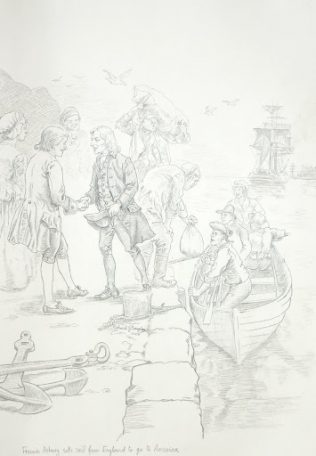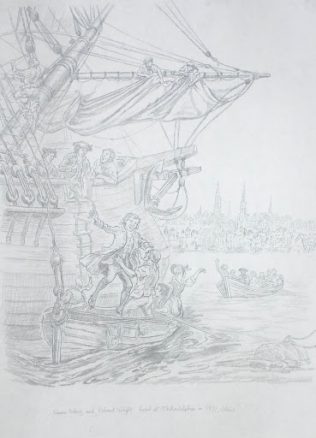Francis Asbury Atlantic Crossing
The Ship Which Delivered the Young Itinerant to America


Francis Asbury Sets Sail
In nearly twenty years of researching Francis Asbury and his Atlantic crossing to the American Colonies, I have not been able to determine the name of the ship which delivered the young itinerant to Philadelphia on Sunday, October 27, 1771. Perhaps it is listed somewhere, but I have not been able to solve this mystery.
Despite the absence of a ship’s name, it is clear that Francis Asbury departed the port of Pill, Bristol England, on Wednesday, September 4, 1771. From the research, it is also clear that Francis Asbury arrived at the port in Philadelphia on Sunday, October 27, 1771. The journal of Francis Asbury clearly mentions these dates of this Atlantic crossing. Sadly, what is missing is the name of the ship which delivered the young itinerant to the beautiful autumn shores of the American Colonies. However, there are facts that clearly lead to two possible ships which delivered a twenty-six-year-old Francis Asbury to America.
Francis Asbury arrival in Philadelphia 1771
The four Philadelphia papers in existence at the time of Francis Asbury’s Atlantic crossing are The Pennsylvania Journal, The Pennsylvania Packet, The Pennsylvania Chronicle and the Pennsylvania Gazette. Each of these publications points to two possible candidates for the ship that carries Francis Asbury to the American colonies.
According to the Pennsylvania Packet dated November 4, 1771, and the Pennsylvania Journal dated October 31, 1771, two ships from Bristol England, (the port of Francis Asbury’s departure), arrived at the Philadelphia port during the week prior to the printing of these two weekly publications. Both the Pennsylvania Packet and the Pennsylvania Journal document The Customs House Inwards-Entries-list with the actual records.
In addition to these notations of recent arrivals, there is a cross reference in the Pennsylvania Journal dated; September 1, 1771. The cross reference to one of the ships in the Pennsylvania Journal gives the November 4 personal account by a Captain Montgomery of the ship, Chalkley, who states that the Captain left Bristol on the first of September and that there were two ship Captains who were planning “to sail in a few days after him.” He gives the names of the two captains, Captain Seymour Hood, and Captain Davidson. This Captain Montgomery reference to two ships in Bristol at the time of the departure date found in the journal of Francis Asbury reveals the two ships in the Bristol port at this time.
Another publication, The Pennsylvania Chronicle, also gives an account of Captain Davidson from Bristol, that “on the 25th of September, in Latitude 40, 3, Longitude 42, spoke Captain McCuddy, in a Brig from Baltimore for Bristol, out 26 days.’ The significance of the term “spoke” is an indication that Captain Davidson’s ship spotted a passing ship in the Atlantic at the location noted.
This data leads to the obvious questions, first, what are the two names of these ships and second, which of these two ships is most likely the vessel which delivered Francis Asbury to the new world?
The Betsey and the Warwick are the two ships listed and cross-referenced in the publications above. See the copy of the Pennsylvania Packet dated October 28, 1771. A copy of front page can be seen here.
The Betsey
A Mr. Seymour Hood captains the Betsey at this time. It apparently is a big ship, a three-masted ship of 300 tons. I’ve come across a ship’s log for the Betsey. It details a voyage in the years 1766 and 1767. I have also found out that Mr. Seymour Hood is from a famous seafaring family. Two British Admirals also sailed at the same time. Their names are Admiral Samuel Hood and Admiral Alexander Hood. Their exact relations I have not been able to uncover.
The Warwick
The Warwick, like the Betsey, is a three-masted ship of 300 tons, a worthy craft for an Atlantic crossing. The Pennsylvania Chronicle for the week of October 21 to 28 of 1771 lists an advertisement for an importer by the name of John Mason. The ad states, ‘John Mason, has just imported in the ship Warwick, Captain Davidson, from Bristol, a neat assortment of the sundry undermentioned articles, which are for sale, at his store in Front Street, near Market Street, viz. The best Wilton Carpeting… bed quilts…’ The ad goes on to state an interesting fact, the ship is loaded with Toys and fine “Queen’s Ware China.” Did Asbury sail over on a ship full of toys? Interesting thought. It would sit well with his unique sense of humor. An additional advertisement for a woman named, Mary Eddy, states that she has “a large and very neat assortment of Ironmongery, cutlery, saddlery and glassware,” all imported recently from Bristol. Asbury works in and hails from the iron-working capital of the world at that time, the West-Midlands of England. It would make sense that the ship originating from the Bristol port would be carrying items from the ironworking industry.
Further Details of The Betsey and The Warwick
The Pennsylvania Journal for October 31, 1771, gives a little more detail about the ships. For the Warwick, it states that the ships captain is Samuel Davidson and, “Has good accommodations for passengers, having a great part of her cargo engaged, will sail in 3 weeks. For freight or passage apply to said Master, (Samuel Davidson), on board at Captain Goodman’s wharf.”
For the Betsey, The Pennsylvania Journal lists Seymour Hood, Master, “Is taking in for Bristol. She is a good new vessel, with neat accommodations for passengers, the chief part of her cargo being ready to go on board, is intended to sail about the 15th of November. For freight or passage, apply to Thomas Clifford and Son, or the Master on board at their wharf. A great variety of Merchandise, imported in said ship from Bristol, and the last vessels from London, Liverpool & Hull, to be sold on reasonable terms by Thomas Clifford and Son, at their store in Water-Street.”
In my opinion influenced by nearly two decades of research about Francis Asbury, the young preacher’s Atlantic crossing occurred on one of the two ships. The Atlantic crossing either occurred on the Betsey or the Warwick.
Further details for this article can be found at the original article.





No Comments
Add a comment about this page